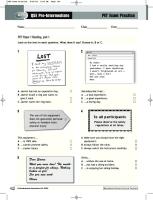Practice Exam 03
91962_01_s12-p0001-0176 6/8/09 9:24 AM Page 161 © 2010 Pearson Education, Inc., Upper Saddle River, NJ. All rights r
Views 128 Downloads 1 File size 689KB
Recommend stories
- Author / Uploaded
- Andrew Hopwood
Citation preview
91962_01_s12-p0001-0176
6/8/09
9:24 AM
Page 161
© 2010 Pearson Education, Inc., Upper Saddle River, NJ. All rights reserved. This material is protected under all copyright laws as they currently exist. No portion of this material may be reproduced, in any form or by any means, without permission in writing from the publisher.
*12–212. The man pulls the boy up to the tree limb C by walking backward at a constant speed of 1.5 m>s. Determine the speed at which the boy is being lifted at the instant xA = 4 m. Neglect the size of the limb. When xA = 0, yB = 8 m, so that A and B are coincident, i.e., the rope is 16 m long.
C
yB 8m B
Position-Coordinate Equation: Using the Pythagorean theorem to determine lAC,
A
we have lAC = 2x2A + 82. Thus, l = lAC + yB 16 = 2x2A + 82 + yB yB = 16 -
2x2A
xA
+ 64
[1]
dxA Time Derivative: Taking the time derivative of Eq. [1] and realizing that yA = dt dyB and yB = , we have dt dyB xA dxA = 2 dt 2xA + 64 dt xA yB = yA 2 2xA + 64
yB =
[2]
At the instant xA = 4 m, from Eq. [2] yB = -
4 24 + 64 2
(1.5) = - 0.671 m>s = 0.671 m>s c
Ans.
Note: The negative sign indicates that velocity yB is in the opposite direction to that of positive yB. 161
91962_01_s12-p0001-0176
6/8/09
8:56 AM
Page 128
© 2010 Pearson Education, Inc., Upper Saddle River, NJ. All rights reserved. This material is protected under all copyright laws as they currently exist. No portion of this material may be reproduced, in any form or by any means, without permission in writing from the publisher.
•12–165. A car travels along the circular curve of radius r = # 300 ft. At the instant shown, its angular rate of rotation is u = 0.4 rad>s, which is increasing at the rate of $ u = 0.2 rad>s2. Determine the magnitudes of the car’s velocity and acceleration at this instant.
A
r ⫽ 300 ft
.
u ⫽ 0.4 rad/s u ⫽ 0.2 rad/s2
Velocity: Applying Eq. 12–25, we have # # yr = r = 0 yu = ru = 300(0.4) = 120 ft>s
..
u
Thus, the magnitude of the velocity of the car is y = 2y2r + y2u = 202 + 1202 = 120 ft>s
Ans.
Acceleration: Applying Eq. 12–29, we have # $ ar = r - ru2 = 0 - 300 A 0.42 B = - 48.0 ft>s2 $ ## au = ru + 2ru = 300(0.2) + 2(0)(0.4) = 60.0 ft>s2 Thus, the magnitude of the acceleration of the car is a = 2a2r + a2u = 2( - 48.0)2 + 60.02 = 76.8 ft>s2
Ans.
128
91962_06_s16_p0513-0640
6/8/09
2:10 PM
Page 518
© 2010 Pearson Education, Inc., Upper Saddle River, NJ. All rights reserved. This material is protected under all copyright laws as they currently exist. No portion of this material may be reproduced, in any form or by any means, without permission in writing from the publisher.
16–10. During a gust of wind, the blades of the windmill are given an angular acceleration of a = (0.2u) rad>s2, where u is in radians. If initially the blades have an angular velocity of 5 rad>s, determine the speed of point P, located at the tip of one of the blades, just after the blade has turned two revolutions.
a ⫽ (0.2u) rad/s2 P
2.5 ft
Angular Motion: The angular velocity of the blade can be obtained by applying Eq. 16–4. vdv = adu 4p
v
L5 rad>s
vdv =
L0
0.2udu
v = 7.522 rad>s Motion of P: The speed of point P can be determined using Eq. 16–8. Ans.
yP = vrP = 7.522(2.5) = 18.8 ft>s
518









